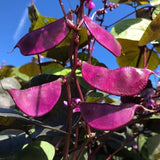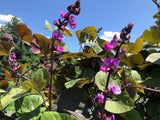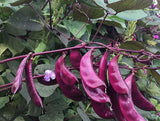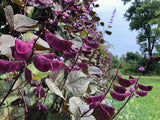Purple Hyacinth Bean
Lablab purpureus
Tall, twining, purple vines cover any trellis or fence with beautiful dark foliage and abundant bright purple pods.
Lablab, or Hyacinth Bean, is widely eaten in parts of South and Southeast Asia, Africa, and the Caribbean. The young pods are boiled and added to curries, sometimes the immature fresh seeds are boiled or roasted, the dried beans can be processed like tofu or sprouted like mung beans, and the leaves and flowers eaten like spinach. The flowers are a beautiful edible addition to salads and desserts and florists love their pink flower clusters and pods on long slender stems. The fresh or dried seeds eaten in large quantities can be toxic if not prepared correctly (double-cooked with two changes of water).
This versatile, drought-tolerant, soil-building species has a center of diversity in much of tropical Africa. Our coworker Amirah Mitchell of Sistah Seeds found it listed in the Lost Crops of Africa (to whom we owe thanks for much of this information), and so she began stewarding this beauty at our farm as part of her work to keep the seeds of the African Diaspora.
Days to maturity: 65 to flower, 115 to young pods
Seeds per pack: 30
Germination rate: 72% on 05/28/2025
Planting / harvesting notes
Plant in warm soil at least a couple weeks after the last danger of frost has passed. Sow directly in the ground at a depth of 1/2 inch, spaced every few inches in rows 12 inches apart. Thin to one plant every 6-12 inches. Provide a sturdy trellis as the vines can grow ten to twenty feet tall! Needs ample sun and good airflow.
Seed keeping notes
Hyacinth Beans are self-pollinating, though it is best to isolate different varieties of Lablab purpureus by 10 to 20 feet to avoid unwanted cross-pollination from flying insects. One source recommends 75-150 feet of isolation, though most recommend the shorter distance. For seed saving, harvest the beans when their shells have become dried and crispy on the plants. Lay out the pods in a dry, sunny place to dry down further. Shell the beans and lay out the seeds in a well ventilated place away from direct sunlight for at least another few days to a week before storing for next year.













